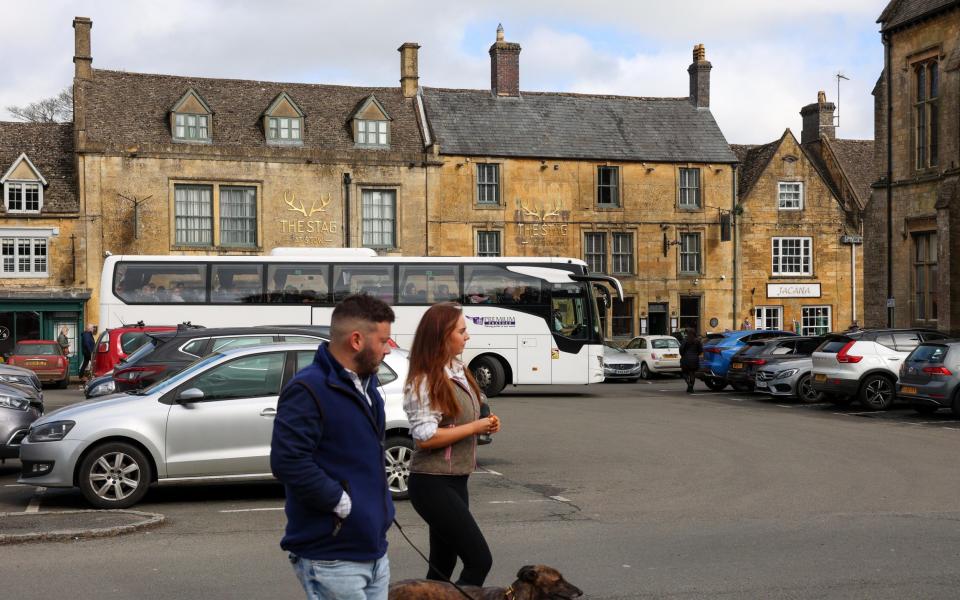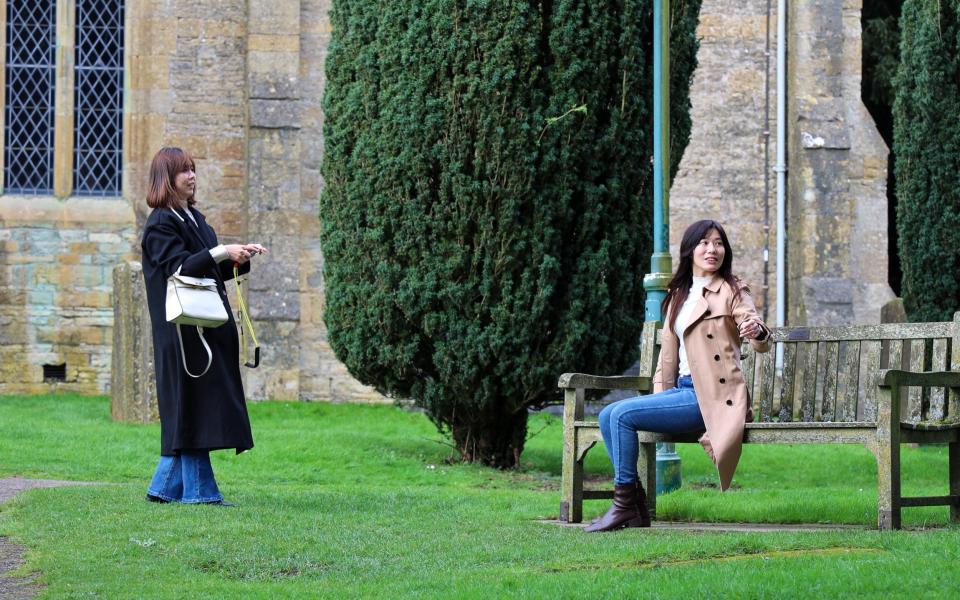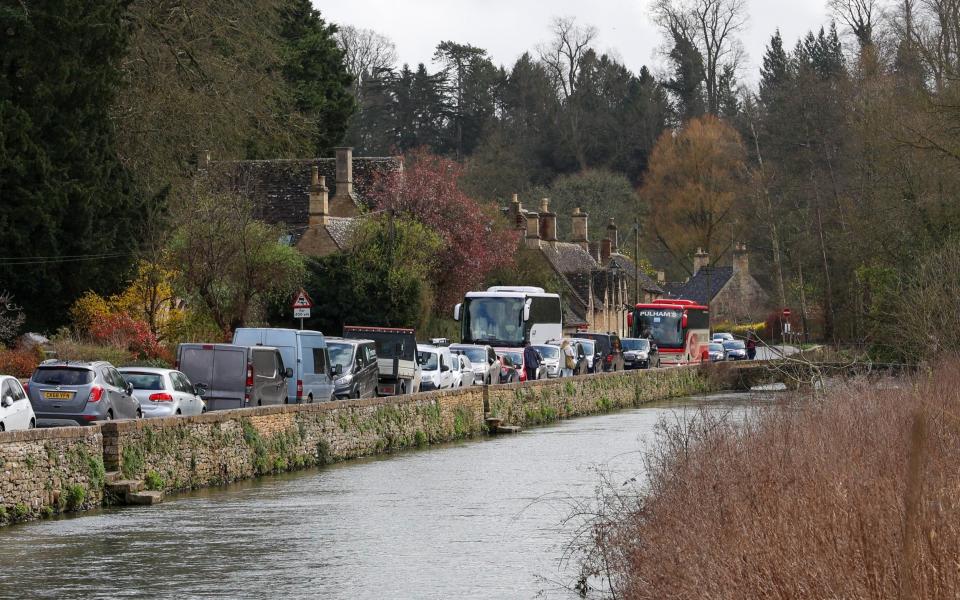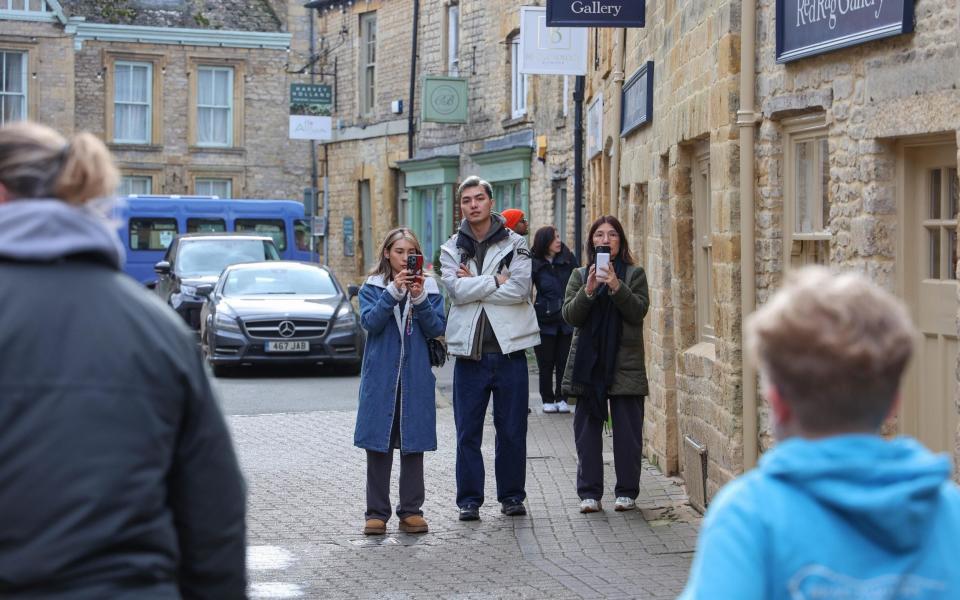“All aboard for lunch in the Cotswolds,” says Derek Lavery, checking names on his clipboard.
It’s 8am at Victoria Coach Station and I’m climbing aboard Premium Tours’ “Britain’s Best Village Lunch” coach to meet the people who are persona non grata in at least one Cotswolds honeypot.
Predictably, perhaps, I am the only Brit in a group of 48, surrounded by a gaggle of American, Australian, Chinese and Japanese tourists. Eighteen of the Americans have gathered and are chatting amiably in the back rows.
“This is one of the best tours across the country in Britain that you could go on, we will see some of the most beautiful scenery in the country and we will have a great pub lunch,” continues Lavery. And with that, we’re off.


Coaches like this have been banned from Bourton-on-the-Water, a village of just over 3,000 residents that attracts large numbers of tourists. Around 238,000 visitors flock to Bourton each year, soaking up the sights and sounds of the medieval village with its picturesque Cotswolds limestone houses, the shallow Windrush River – perfect for paddling – and old-fashioned British pub grub.
The proposed ban would prevent coach access, but has yet to be officially signed off by the roads authority in Gloucestershire County Council. However, a de facto ban has already been implemented.
A former car park near the town center was closed in December, and its replacement opened in February, with no spots for coaches to park. They have to use unofficial drop-off points that have to be fiddled with, or – as we are doing – skip Bourton altogether.
‘They are the only ones who will lose out’
“It’s a shame,” says Sue, who traveled from South Australia with her 11-year-old grandson. “I visited once, probably about 30 years ago, and it’s a very beautiful town. But they are all very nice. If they don’t want tourists there, there are plenty of other places to visit. I’m not too disappointed.”
“I think it’s ridiculous,” says Lavery, when I ask him about the plans. “They are the only ones who will lose out. Bourton-on-the-Water is beautiful and very picturesque, but there is nothing there. If they stop tourists out the whole village will just fall. All the pubs, cafes, restaurants, shops – gone.”
Instead, we are spending more time in the surrounding villages: Burford, Stow-on-the-Wold and Bibury, now our “prettiest village in Britain”.
The two-hour journey out of London and into the Cotswolds is fairly nondescript, but Lavery keeps us entertained with a stream of facts and anecdotes, introducing everything from the famous inhabitants of the Cotswolds to the scene of sheep farming.
“I love it, it’s so cute!” exclaims Jessica, a “50-something” Californian. Although she has visited the UK once before, this is her first time outside of London and she “can’t get over how nice it is”.


Coach trips from Bourton-on-the-Water were not unanimously supported by locals. Pub landlords, cafe owners and gift shop merchants have already expressed dismay – and the positive side is visible in the surrounding villages.
“Bourton’s loss is our gain,” shrugs the woman behind the tills at the sweet shop in Burford. “Tourists are not a problem here, they arrive mid-morning, then they’re gone by 4pm. It’s not like we’re overspent.”
Our tour group arrives at Burford at 10.30, near the Priory, owned by Elizabeth Murdoch, daughter of the newspaper tycoon. Lavery shows the medieval church, the toilets and where to find a local dessert: a lardy cake, a sweet fried bread bun with currants and lots of sugar.
My fellow visitors are spellbound. A couple of American parties have visited them before, “back in 1978 – I really liked it, meeting the locals – from the stories,” says Michael Baker, a retired California sheriff who leads their group. “It hasn’t changed much. It is lovely. Here’s what you want to see when you go out in Britain. I could easily live here. Easily.”
Then it’s back on the bus.


We stop for lunch at The Swan Brasserie in Bibury. It is a small, picturesque upmarket hotel, nestled in the sun by the River Coln. Across the water, I spied Arlington Row, a small parade of 14th-century limestone cottages owned by the National Trust and let out to locals.
A group of Japanese tourists are taking photos of it. Bibury is particularly popular with the Japanese because, in 1921, the country’s crown prince visited during his tour of Europe. He loved Bibury so much that he spoke fondly of it when he returned to his country, which made the village famous in Japan.
At lunch there is a palpable excitement among the other visitors at the idea of visiting a proper English “pub” (I don’t count it as a country hotel dining room). Lavery needs to explain the custom of ordering at the bar as there is some confusion.
We were offered a choice of three options: roast chicken and mashed potatoes, fish pie and ravioli, followed by sticky or crumbled toffee pudding. Pretty British (apart from the ravioli). Lunch is included in the ticket price but a quick glance at Swan’s a la carte menu suggests it would probably cost around £30 each if we had just turned up. We may not be contributing much to the economy of the Cotswolds, but we’ve spent the day stopping at cafes, tea rooms and gift shops. On the bus, I can see my fellow passengers picking up everything from local sheepskin to woven baskets, sweets, books and waxed jackets. It all adds up.
It’s also worth noting that coach tour groups like ours provide a steady stream of diners to places like The Swan, even during the holiday season. Premium Tours run all year round, rain or shine. According to Lavery, today’s group, at 48, is slightly higher than average, but 25-40 is a normal size.


An old cliché in the Cotswolds, at least since coach tours really began in the 1960s, is that while it’s impossible to get a weekday lunch around these parts, tourists don’t tend to be a hindrance when it comes to evening dinner reserved by them – they are. already back on the coach by then. Not the worst trade-off in the world, one might argue.
The lunch goes down well, despite being served a little late. “This whole thing works with mechanical precision,” Lavery tells me. “If one coach journey is 10 minutes late, it delays their service and puts everyone back.” Still, Americans are delighted at how British it all is.
From there we would normally go to Bourton-on-the-Water, but it’s straight to Stow-on-the-Wold instead. The Norman market town is the prime example of the chocolate box. To its core, it seems to have leapt from a foreigner’s wildest imagination as the epitome of what Britain is all about.


Stow-on-the-Wold is a favorite as are Burford and Bibury. The group dutifully pose for selfies outside the church where two yew trees grow on either side of the door (said to have been the inspiration for Tolkien’s Gates Of Moria) and I hear squeals of delight coming from gift shops . and antique emporiums as we pottered around for an hour.
The local response to tourists in Stow is not quite enthusiastic, more like a grudging acceptance. “It can be difficult with the traffic and it’s a bit annoying to be in the back of the cars whenever I go anywhere, but in the end they pay the bills,” says Paul Worthy, dropping several hands at the charity shop.
Having grown up in a tourist location, I appreciate the concern of the parishioners in Bourton-on-the-Water. At best, over-tourism is a terrible nuisance, preventing local people from being able to enjoy the homes and amenities, at worst it drives up prices, hollows out communities and six people against each other.


But after a very enjoyable coach ride, I can’t help but think Bourton picked the wrong side of tourism to dismiss. My fellow travelers were interested, engaged, respectable and – having been willing to pay £121 for a day trip – rich enough to splurge in the local shops and restaurants. We did not welcome him in any particular place, staying in each village long enough not to step under anyone’s feet.
OK, so a large coach turning around might back up traffic for a few minutes, but what’s worse – one coach or 24 cars pushing up the roads? Best of all, by 4 o’clock we were free, leaving the locals to enjoy their area in peace.
Jack traveled on the ‘Lunch in the Prettiest Village in Britain’ coach tour from Premium Tours, starting at London Victoria Coach Station and visiting Burford, Bibury and Stow-on-the-Wold.